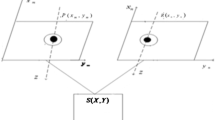Abstract
Stereoscopic video is the new era in video viewing and has wide applications such as medicine, satellite imaging and 3D Television. Such stereo content can be generated directly using S3D cameras. However, this approach requires expensive setup and hence converting monoscopic content to S3D becomes a viable approach. This paper proposes a depth-based algorithm for monoscopic to stereoscopic video conversion by using the y axis co-ordinates of the bottom-most pixels of foreground objects. This code can be used for arbitrary videos without prior database training. It does not face the limitations of single monocular depth cues nor does it combine depth cues, thus consuming less processing time without affecting the efficiency of the 3D video output. The algorithm, though not comparable to real-time, is faster than the other available 2D to 3D video conversion techniques in the average ratio of 1:8 to 1:20, essentially qualifying as high-speed. It is an automatic conversion scheme, hence directly gives the 3D video output without human intervention and with the above mentioned features becomes an ideal choice for efficient monoscopic to stereoscopic video conversion.

Similar content being viewed by others
References
Zhang Liang, Carlos Vázquez, and Sebastian Knorr (2011) 3D-TV Content Creation: Automatic 2D-to-3D Video Conversion, IEEE Transactions on Broadcasting, 57(2): 372–383.
P. V. Harman (2011) Home-based 3D Entertainment-An Overview, IEEE Int. Conf. Image Process, Vancouver, 1: 1–4.
J. Shade, S. Gortler, L. He. and R Szeliski (1998) Layered Depth Image, Proc. SIGGRAPH’98, 43–54.
Q. Wei (2005) Converting 2D to 3D: A Survey, Delft University of Technology, The Netherlands, Project Report.
S. C. Chan, H. Y. Shum and K. T. Ng (2007) Image-based Rendering and Synthesis, IEEE Signal Process. Mag., 22–33.
Favaro (2002) Shape from focus/defocus, Washington University, Department of Electrical Engineering Electronic Signals and Systems Research Lab.
D. A. Forsyth (2002) Shape from texture without boundaries, in ECCV02, 225–239.
A. M. Loh and R. Hartley (2005) Shape from nonhomogeneous, non-stationary, anisotropic, perspective texture, Proc. British Mach. Vis. Conf.
R. Zhang, P.-S. Tsai, J. E. Cryer, and M. Shah (1999) Shapefrom-shading: A survey, IEEE Trans. Pattern Anal. Mach. Intell., 21(8): 690–706.
Ton Derksen (1999) Discovery of linear perspective and its limitations, Philosophica, 63, pp. 19–50 Available: http://logica.ugent.be/philosophica/fulltexts/63-3.pdf
S. Battiato, S. Curti, M. La Cascia, M. Tortora, and E. Scordato (2004) Depth map generation by image classification, Proc. SPIE, 5302: 95–104.
George Mather (2008) Foundations of Sensations and Perception, Chapter 10: Depth Perception, Second Edition, Psychology Press, UK.
Y.-J. Jung, A. Baik, and D. Park (2009) A 2D-to-3D conversion technique based on relative height-depth-cue, in SPIE Conf. Stereoscopic Displays Appl. XX, San José, CA, 7237: 72371U.
Mallory F. R. R. (2011) Types of Monocular Depth Cues, Available: http://www.ehow.com/about_5042449_typesmonocular-depth-cues.html
Krantz John H., Ph.D. (2012) Linear Perspective, Sensation and perception tutorials, Available: http://psych.hanover.edu/krantz/art/linear.html
Michael S Landy, Laurence T Maloney, Elizabeth B Johnston, Mark Young (1995) Measurement and Modelling of Depth Cue Combination: in Defense of Weak Fusion, New York University.
Paul R. Schrater and Daniel Kersten (1999) The Role of Task Specification in Optimal Cue Integration, University of Minnesota.
Amisha H. Somaiya, Ramesh K. Kulkarni (2012) High Speed Automatic Depth Map Generation for 3D Television, European Scientific Journal, 8(30): 127–142
Yue Feng, Jinchang Ren and Jianmin Jiang (2011) Object-Based 2D-to-3D Video Conversion for Effective Stereoscopic Content Generation in 3D-TV Applications, IEEE Trans. on Broadcasting, 57(2): 500–509.
Sung-Fang Tsai, Chao-Chung Cheng, Chun-Te Li and Laing-Gee Chen (2011) A Real-Time 1080p 2D-to-3D Video Conversion System, IEEE Trans. on Consumer Electronics, 57(2): 915–922.
Xun Cao, Zheng Li, and Qionghai Dai (2011) Semi-Automatic 2D-to-3D Video Conversion using Disparity Propagation, IEEE Trans. on Broadcasting, 57(2): 491–499.
Author information
Authors and Affiliations
Corresponding author
Rights and permissions
About this article
Cite this article
Somaiya, A.H., Kulkarni, R.K. Efficient and high speed depth-based 2D to 3D video conversion. 3D Res 4, 5 (2013). https://doi.org/10.1007/3DRes.03(2013)5
Published:
DOI: https://doi.org/10.1007/3DRes.03(2013)5




